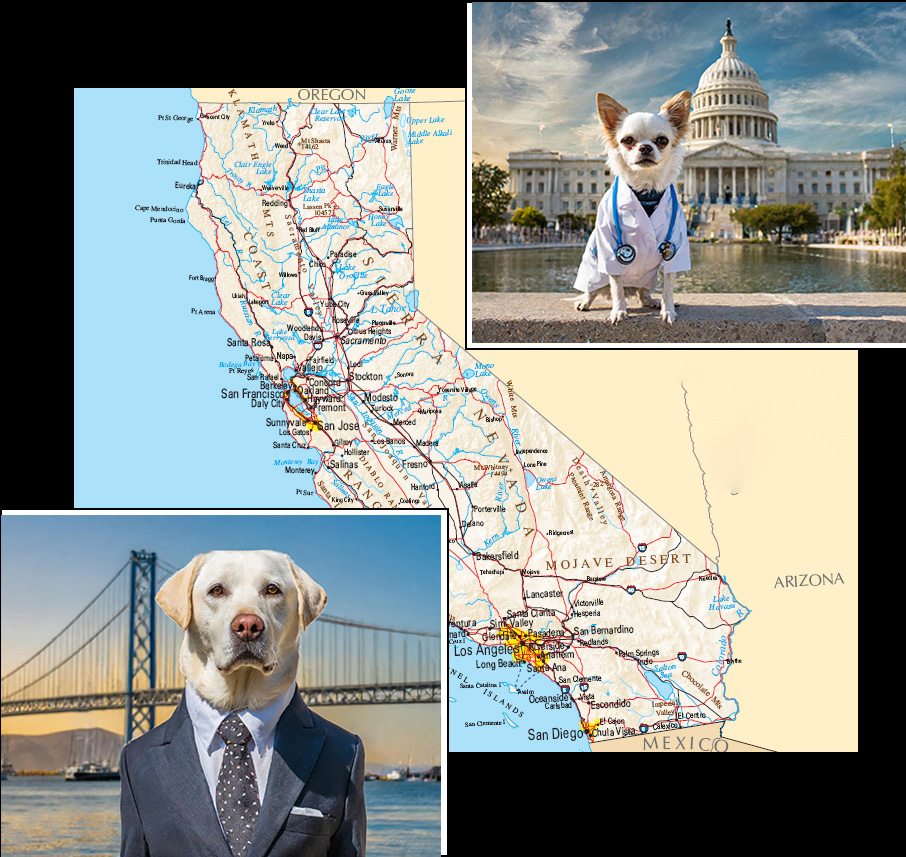Alcohol Justice's Best and Worst of 2023: CALIFORNIA
 Indefatigable watchdogs Buster (angry) and Sergio (stoked) rate last year's major developments in the California alcohol landscape.
Indefatigable watchdogs Buster (angry) and Sergio (stoked) rate last year's major developments in the California alcohol landscape.
Sergio prevents; Buster just vents.
—
The Indefinite Extension of Regulatory Relief 
How soon we forget.
When the COVID-19 outbreak started spreading in California in March of 2020, Governor Newsom issued a stay-at-home order that severely restricted public gathering places, notably including restaurants and bars. To offset this, the California Department of Alcoholic Beverage Control issued a number of “regulatory relief” orders, allowing these retailers newfound privileges to access delivery, serve as alcohol takeaway outlets, and expand their serving capacity beyond that allowed in the license. These orders, California residents were assured, would only last so long as the emergency order was in place.
Since then, however, Gov. Newsom and the legislature have extended nearly all of them, creating a state of “permanent emergency” measures. In 2023, bills to continue the expanded footprints and delivery by post passed (as did a heavily amended bill that would allow greatly expanded outdoor consumption in San Francisco), while bills intended to extend delivery privileges were introduced but stalled—quite possibly because they put too much pressure on delivery companies. This state of eternally extended short-term deregulation comes as California faces shocking increases in alcohol-related death (see below). The hope is that the legislature will wake up to its own role in perpetuating harm, because its currently engaged in a steady, blind downwards spiral.
—
Bud Ads for Undergrads

Alcohol underlies all the leading causes of death for young adults. It plays a significant role in accidents, crashes, homicide, and suicide, and has a synergistic effect on opioids that increase overdose risk. Moreover, alcohol is involved in a number of outcomes that derail educational careers, including violence, sexual assault, and academic difficulties. So, it stunned community health and school safety advocates when self-described education-focused legislator Dawn Addis (D-San Luis Obispo) introduced a bill that would greatly expand the alcohol industry’s ability to advertise on California State University (CSU) campuses.
By stripping away existing bans on advertising in major campus recreational facilities, the bill would raise a nominal amount of money in ad sales. That amount, however, was trivial—less than $1 million, against a debt likely exceeding $8,800 million. Worse, administrators from CSU campuses bragged that these ads would be shown, not just to students at the university, but to elementary school students in the community.
This cruel money-grubbing has happened before; San Diego State university recently expanded its ability to sell ads to Big Alcohol, resulting in one producer branding itself “The Official Vodka of San Diego State” even as the school faced blowback from sexual assault at parties. But Addis’s proposal expands this recklessly across eight additional campuses and creates the template by which Big Alcohol can buy its way into hundreds of thousands of underage students’ daily lives.
—
Governing Under the Influence (GUI)

Do our leaders create a social climate, or do they reflect it? This is not a mere philosophical exercise for folks working to promote public health and safety. Fact of the matter is, alcohol is considerably less tightly regulated now than it was five years ago, and five years ago it was much less tightly regulated than 25 years ago. Our governor, in fact, made his fortune in the alcohol industry. And our legislators have a nasty habit off getting into alcohol-involved scrapes. In 2018, then-Assemblymember Cristina Garcia told KQED, “At some point I’ve had a keg at my office. A lot of us do.” It is not clear who else has that cavalier an attitude towards both alcohol consumption and running an effective workplace, but the fact remains that legislators keep running into deeply concerning alcohol-related trouble.
The past year saw not one but two legislators charged with driving under the influence of alcohol. State Senator David Min and Assemblymember Wendy Carrillo both found themselves facing legal and public scrutiny for dangerous driving. This raises two questions: were either of them capable of drawing a broader connection between the alcohol sales environment and their own decisions to drive when incapacitated, and will either of them adjust their voting record accordingly?
The optimist in us hopes they will, and that something constructive for California will result from their legal entanglements. But Buster knows Min and Carrillo will absolutely not be the last lawmakers embroiled in reckless consumption amidst a disintegrating regulatory environment.
—
Alcohol-Related Mortality Soared in California

California Department of Public Health (CDPH) has the potential to play an outsize role in resetting the agenda for alcohol policy in the state. It is often hesitant to do so, however, whether from political pressure, scant resources, or learned powerlessness. Now, though, hot on the heels of the perpetually temporary deregulation of alcohol, CDPH has launched the Alcohol Harms Prevention Initiative (AHPI), leading with a deeply disturbing report on alcohol mortality in the state.
The modestly titled “Deaths from Excessive Alcohol Use in California” report shows the true breadth of runaway alcohol consumption during the COVID-19 pandemic. Using methods honed by the U.S. Centers for Disease Control and Prevention, the CDPH team estimated 19,335 alcohol-related deaths per year. This is up from 10,811 in 2015, an increase of 79% in under a decade.
The news is bleak and strongly suggests a multitude of regulatory failures, including the abandonment of evidence-based environmental prevention strategies. However, Buster sees reason for optimism: the introduction of the AHPI. CDPH’s embrace of alcohol harm as a priority area adds another deeply needed voice to the fight for compassionate and effective alcohol policy.
—
Alcohol Justice Researchers Uncover Policy Patterns and the Quilt of Harm

There has long been a feeling that the California legislature has been dismantling the protective alcohol regulatory infrastructure for a while now. Feelings, however, are not science. Alcohol Justice researchers combed through every piece of alcohol-related legislation over the past 10 years to see whether this was true, and what areas of protective policy were most under threat.
The findings were stark: alcohol-related legislation rapidly increased, from 52 in the 2013-2014 legislative session to 92 in the 2021-2022 session. Over the ten-year period, of those signed into law, over twice as many bills were out of compliance with World Health Organization best practices. The report went further into exactly what kinds of harmful legislation was most likely to pass, and can be accessed here.
Though the findings were discouraging, our staff were heartened to find Sergio approved of the project and its potential to shine light on out-of-control legislative priorities.
—
A Pro to Head Up Alcoholic Beverage Control

The California Department of Alcoholic Beverage Control (ABC) is far from the sexiest institution in the government. But it is vital, not just in enforcing the alcohol code broadly, but in determining how limited resources are allocated, providing clarity and boundaries around practices that skirt the edge of written law, and serving as the voice of experience on alcohol harm matters within the government. It does not, however, answer only to public health voices; indeed, it often has weighed industry desires in its decisions. For decades, the agency was a black box to public health and safety advocates.
This opacity was lifted in 2018 by its director Jacob Applesmith and his deputy and successor, Eric Hirata. They perpetuated a program of open meetings with community advocates, including organizations within the California Alcohol Policy Alliance (CAPA). However, when Hirata stepped down last year, there was a moment of tension and fear.
The ABC Director is not an open hire. The position is appointed by the Governor, and this always runs the risk of an industry flack stepping into the position, a risk that weighed heavy in light of Newsom’s heavily alcohol-industry-connected background. Fortunately, the Governor acted in the best interests of the state, appointing Joe McCullough to the position. McCullough not only has a long history of service within ABC, but has been a constant, committed, and responsive contributor to the ABC–CAPA relationship. Sergio is excited to work with him, as are we all.
—
Vineyard Workers Overcome Legislative Roadblocks

The myth and ghost of Cesar Chavez is wound tightly into the spirit of California. So, it came as a shock with Gov. Newsom vetoed a plan that would allow California agricultural workers—substantial among them, the individuals tasked with harvesting California’s wine grapes—the opportunity to elect unionized status free of employer interference.
Under previous rules, union elections had to be by ballot on-site at employer worksites, an increasing logistical nightmare as technology, social distancing, and land consolidation dispersed workers further and further across the employer properties. Under the new rules, the workers can elect to join a union by signing cards declaring support, a policy known as “card check”. Winery owner and California Governor Gavin Newsom vetoed the original version of this bill, which would have also allowed vote-by-mail options, but eventually agreed to the card-check only iteration.
On top of the general association between substandard working conditions and overall predatory industry behavior, exploitation has itself historically harmed generations in this state.
And, as Sergio has oftened howled from picket lines, an alcohol-related harm to one is an alcohol-related harm to all.
—
Testing Testing 1-2-3

As far as alcohol risk is concerned, the phenomenon of drink-spiking exists in a indeterminate, overlooked space. Having a drug--normally a sedative/hypnotic like GHB or rohypnol, though any unwanted drug meets the definition—to an unsuspecting victim’s drink is known to happen, although the reported prevalence varies wildly. The practice is most likely a component of attempted sexual assault, although researchers have identified a number of other motives among perpetrators. Moreover, studies have shown it is does not only happen to women. What is well known, however, is that the experience can be deeply traumatic even if the victim experiences nothing more than severe, unplanned intoxication.
The solution is simple, and the California legislature cottoned onto it. In one of the precious few protective bills in 2023, Assemblymembers Josh Lowenthal and Diane Dixon successfully guided AB 1013 onto the Governor's desk. This new law requires all bars to provide, at or near cost, drink testing kits for common adulterants. This policy offers both protection in the short run, and a sense of security for victims in the longer run. In the best possible world, it establishes drink testing as a norm, discouraging spiking from ever happening in the first place.
—
Just the Tax, Ma’am

Time and time again, research has demonstrated that alcohol tax increases are a simple, effective, and publicly popular method to offset alcohol harm. Not only does the price point lead to consumption dropping—and dropping disproportionately among the heaviest drinkers—but the revenue raised can be immediately diverted to fund prevention, treatment, and recovery. Yet the policy remained, and remains, highly politically unpalatable in California, where alcohol taxes have not been raised since 1991. And unlike sales taxes, which are percentages of a total transaction, alcohol-specific excise taxes are fixed amounts per quantity of alcohol produced. That makes that 1991 amount worth less every year; with the inflation of the last couple years, its current value is less than half of what it was the last time it was raised.
But if alcohol taxes do not have friends in the capitol, they seem to have gained some in the press. Along with the New York Times (see WORLDWIDE), influential political newsletter CalMatters published a detailed call for a modernized alcohol excise tax. Drawing on experts including, but not limited to, Alcohol Justice, journalist Dan Walters makes the case that a cash-strapped state should stop blinding itself to the significance of stalled and stale tax levels.
Sergio agrees enthusiastically, although he would like to emphasize that the most effective alcohol tax schemes aren’t per product—they’re set according to alcohol by volume (ABV).
—
CAPA Coast to Coast

The California Alcohol Policy Alliance (CAPA) was founded in the mid-2010s in the wake of the coalition opposing unlicensed alcohol service in bars and salons. Since then, it has become an insistent voice of reason in alcohol policy, and a locus for public health and safety groups throughout the state to focus their energies on rational alcohol policy. At the end of the year, Alcohol Justice likes to take stock of CAPA’s successes. But nothing speaks so loudly to their accomplishments as their integration into even broader groups.
Under new director Raul Verdugo, CAPA has served as a consultant in a number of ongoing alcohol policy fights, including the rapidly snowballing Georgia Alcohol Policy Alliance and the national Alcohol Action Network, intended to bridge researchers and advocates across all states. CAPA also lent its voice to the desperately needed efforts in New Mexico to combat alcohol harm through tax increases and critically needed new services—a legislative battle that continues in 2024.
There are many things to celebrate simply in the organization being able to lend capacity to those fights. But above and beyond all of it is the realization that protecting public health and safety in 2024 will be a collective effort. Be it an alliance or an alliance of alliances, alcohol advocacy does not work as a lone-wolf effort. But it deserves many Sergios.
—
From CAPA and Alcohol Justice: thank you, advocates, allies, and those who care, for your tireless work in 2023 and every year.
—
READ MORE about the Best and Worst of 2023: WORLDWIDE
Help us hold Big Alcohol accountable for the harm its products cause.
| GET ACTION ALERTS AND eNEWS |
STAY CONNECTED    |
CONTACT US 24 Belvedere St. San Rafael, CA 94901 415-456-5692 |
SUPPORT US Terms of Service & Privacy Policy |


